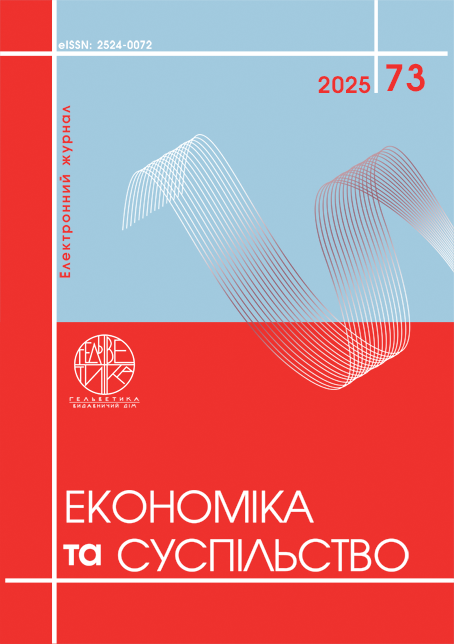THE CONCEPTUAL ROLE OF THE SHADOW ECONOMY IN ECONOMIC GROWTH
Abstract
The article examines the conceptual role of the shadow and gray economies in economic growth and substantiates the need to take them into account in multifactor models of economic development. The general division of the economy into white (official), gray and shadow economies, their characteristics and peculiarities of influence on macroeconomic indicators are considered. The official economy operates within the framework of the law, provides tax revenues, promotes employment growth and investment attractiveness. The gray economy, although not illegal, partially escapes state control, which leads to tax evasion and distortion of economic processes. The shadow economy encompasses illegal activities that may contribute to the short-term survival of a business, but in the long run undermine economic stability. It is proposed to include indicators of the shadow and gray economies in multivariate economic growth models to increase the degree of adaptability of the models and to make more accurate forecasts. In economic growth models, the gray economy is taken into account by adjusting the savings parameters, while the shadow economy requires the introduction of a separate capital intensity equation based on its own production function. To correctly reflect its impact, expressions describing shadow savings and investment are added to the equation of aggregate savings.
References
Kolyada Yu., Poznyak S., Ramskyi A., Shevchenko S. (2024). Adaptation applying of economic growth theoretical models. Digital economy concepts technology workshop 2024, 22–35, https://ceur-ws.org/Vol-3665/paper3.pdf (accessed April 5, 2025)
Kolyada Y., Poznyak S. (2024). Adaptyvna model ekonomichnoho zrostannia dlia vidkrytoi ekonomiky [Adaptive model of economic growth for an open economy]. Natsionalni interesy Ukrainy – National interests of Ukraine, 2(2). https://doi.org/10.52058/3041-1793-2024-2(2)-267-286 (accessed April 5, 2025)
Kolyada Y., Poznyak S. (2024). Adaptyvna model zrostannia vidkrytoi ekonomiky [Adaptive model of open economy growth]. Teoriia modernizatsii v konteksti suchasnoi svitovoi nauky – The theory of modernization in the context of modern world science. https://doi.org/10.62731/mcnd-02.08.2024.001 (accessed April 5, 2025)
Alfano, M. R., Capasso, S., Ciucci, S., & Spagnolo, N. (2024). The non-linear effect of income on the shadow economy. Socio-economic planning sciences, 102041. https://doi.org/10.1016/j.seps.2024.102041 (accessed April 5, 2025)
Bashlakova, V., & Bashlakov, H. (2020). The study of the shadow economy in modern conditions: theory, methodology, practice. The quarterly review of economics and finance. https://doi.org/10.1016/j.qref.2020.10.032 (accessed April 5, 2025)
Chu, L. K., Doğan, B., Ghosh, S., & Shahbaz, M. (2023). The influence of shadow economy, environmental policies and geopolitical risk on renewable energy: a comparison of high- and middle-income countries. Journal of environmental management, 342, 118122. https://doi.org/10.1016/j.jenvman.2023.118122 (accessed April 5, 2025)
Ha, L. T., Dung, H. P., & Thanh, T. T. (2021). Economic complexity and shadow economy: a multi-dimensional analysis. Economic analysis and policy, 72, 408–422. https://doi.org/10.1016/j.eap.2021.09.011 (accessed April 5, 2025)
Saunoris, J. W. (2023). Individualism, economic freedom, and the development of the shadow economy. Economic systems, 101168. https://doi.org/10.1016/j.ecosys.2023.101168 (accessed April 5, 2025)
Kolyada Yu., Poznyak S., Ramskyi A., Shevchenko S. Adaptation Applying of Economic Growth Theoretical Models. Digital economy concepts technology workshop 2024. 2024. pp. 22–35. URL: https://ceur-ws.org/Vol-3665/paper3.pdf (дата звернення: 05.04.2025).
Коляда Ю., Позняк С. Адаптивна модель економічного зростання для відкритої економіки. Національні інтереси України. 2024. № 2(2). URL: https://doi.org/10.52058/3041-1793-2024-2(2)-267-286 (дата звернення: 05.04.2025).
Коляда Ю., Позняк С. Адаптивна модель зростання відкритої економіки. Теорія модернізації в контексті сучасної світової науки. 2024. URL: https://doi.org/10.62731/mcnd-02.08.2024.001 (дата звернення: 05.04.2025).
The non-linear effect of income on the shadow economy / M. R. Alfano et al. Socio-economic planning sciences. 2024. P. 102041. URL: https://doi.org/10.1016/j.seps.2024.102041 (дата звернення: 05.04.2025).
Bashlakova V., Bashlakov H. The study of the shadow economy in modern conditions: theory, methodology, practice. The Quarterly review of economics and finance. 2020. URL: https://doi.org/10.1016/j.qref.2020.10.032 (дата звернення: 05.04.2025).
The influence of shadow economy, environmental policies and geopolitical risk on renewable energy: a comparison of high- and middle-income countries / L. K. Chu et al. Journal of environmental management. 2023. Vol. 342. P. 118122. URL: https://doi.org/10.1016/j.jenvman.2023.118122 (дата звернення: 05.04.2025).
Ha L. T., Dung H. P., Thanh T. T. Economic complexity and shadow economy: a multi-dimensional analysis. Economic analysis and policy. 2021. Vol. 72. P. 408–422. URL: https://doi.org/10.1016/j.eap.2021.09.011 (дата звернення: 05.04.2025).
Saunoris J. W. Individualism, economic freedom, and the development of the shadow economy. Economic systems. 2023. P. 101168. URL: https://doi.org/10.1016/j.ecosys.2023.101168 (дата звернення: 05.04.2025).

This work is licensed under a Creative Commons Attribution 4.0 International License.


